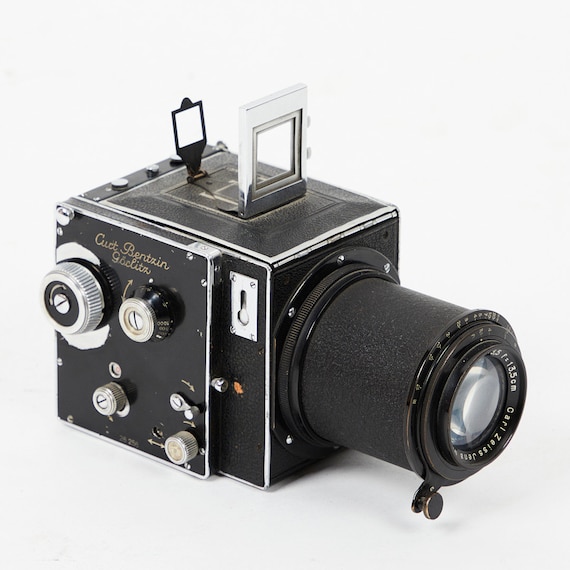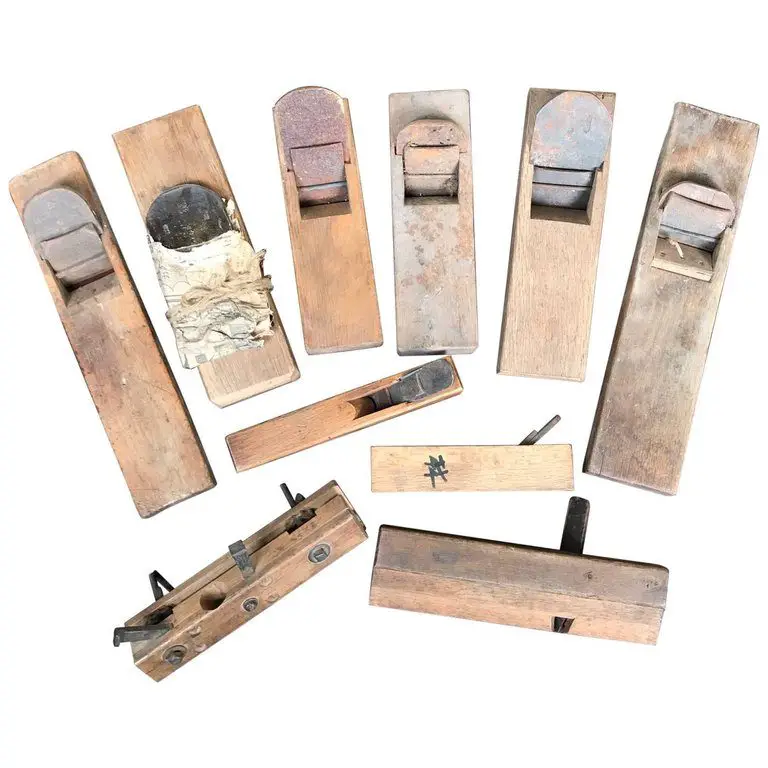An antique wood hand planer is a vintage tool used for shaping and smoothing wooden surfaces. It is a valuable collectible item for woodworking enthusiasts and collectors alike.
With its rich history and craftsmanship, an antique wood hand planer serves as a testament to the ingenuity and skill of craftsmen of the past. These hand tools were commonly used before modern power tools became prevalent. An antique wood hand planer typically consists of a sharp iron blade secured in a sturdy wooden body.
The blade is adjusted to different depths to control the amount of material being shaved off the wood. Today, antique wood hand planers are sought after for their aesthetic appeal, functionality, and historical significance. Whether used for woodworking projects or displayed as a decorative piece, these vintage tools add a touch of charm and nostalgia to any setting.

Credit: www.etsy.com
Exploring The History
Uncovering the fascinating history behind antique wood hand planers allows us to appreciate the craftsmanship and ingenuity of the past. These timeless tools have played a vital role in shaping the world we live in today. From their early origins to the evolution of their design, every aspect tells a story of innovation and skill. Let’s delve into the intriguing history of antique wood hand planers and the impact they have had on woodworking throughout the centuries.
Early Origins
The origins of the wood hand planer can be traced back centuries, with evidence of their use in ancient civilizations like Egypt, Greece, and Rome. However, these early planers were simple in design and primarily made of wood, lacking the advanced features we see in the antique planers of later times.
As woodworking techniques evolved, so did the hand planer. In the Middle Ages, planers became more refined, often incorporating metal components to enhance their durability and efficiency. These early adaptations marked the beginning of a new era in woodworking, as craftsmen recognized the value of precision and accuracy in their work.
Evolution Of Design
The design of antique hand planers gradually evolved over time, reflecting new advancements in technology and the changing needs of craftsmen. One significant turning point came in the 18th century with the introduction of mass production techniques. This revolutionized the industry, allowing hand planers to be produced on a larger scale.
During the Industrial Revolution in the 19th century, machine-made hand planers gained popularity, incorporating adjustable blades and improved ergonomic features. The use of cast iron and steel in their construction offered increased stability and durability, ensuring a longer lifespan for these essential woodworking tools.
Notable figures such as Leonard Bailey and Stanley took the evolution of hand planers to new heights in the late 19th and early 20th centuries. These innovators introduced various improvements, including adjustable mouths, depth stops, and improved blade mechanisms. Their inventions not only enhanced the functionality of hand planers but also paved the way for modern power tools that we use today.
Summing Up
The journey of antique wood hand planers from their humble beginnings to their refined designs showcases the human ingenuity and commitment to craftsmanship. These historic tools have left an indelible mark on the world of woodworking, shaping both the pieces they helped create and the artisans who wielded them. Exploring the history of these remarkable hand planers allows us to appreciate the legacy they have left behind and the lasting impact they continue to have in the world of woodworking.
Identifying Antique Hand Planers
Antique hand planers are timeless treasures that not only serve a practical purpose but also provide a glimpse into the craftsmanship of bygone eras. Whether you are an avid collector or simply appreciate the beauty of vintage tools, being able to identify authentic antique hand planers is key. In this article, we will explore the key features and signs of authenticity to look for when assessing these fascinating pieces of history.
Key Features
Antique hand planers often possess unique characteristics that set them apart from modern counterparts. Understanding the key features can help you recognize the age and origin of these valuable tools:
- Material: Antique hand planers were typically crafted from hardwood, such as rosewood or beech. The quality and type of wood used can provide valuable clues about the planer’s age and authenticity.
- Design: Vintage hand planers often showcase intricate designs and decorative elements. Look for ornate detailing, such as carved handles or embellished bodies, as these can indicate the craftsmanship and era of the planer.
- Size and Weight: Antique hand planers can vary in size and weight, depending on their purpose and time period. Smaller, lighter planers were often used for finer woodworking tasks, while larger, heavier ones were employed for more substantial projects.
- Blade Construction: Pay attention to the blade of the hand planer. Antique blades were usually made of high-quality steel, with marks or engravings indicating the manufacturer. A well-preserved, original blade is a strong indicator of authenticity.
- Mechanical Features: Vintage hand planers may have unique mechanical features that distinguish them from modern versions. Look for adjustable mouths, depth controls, or any other mechanisms that reflect the innovation of their time.
Signs Of Authenticity
Assessing the authenticity of an antique hand planer requires a keen eye for detail. Here are some signs to look out for:
- Patina and Wear: Genuine antique hand planers will exhibit natural signs of wear, such as patina, scratches, and dents. These age-related imperfections add character and authenticity to the tool.
- Branding and Markings: Authentic hand planers may bear the manufacturer’s logo or other identifying marks. Researching and verifying these markings can help determine the planer’s origin and ensure its authenticity.
- Provenance and Documentation: If possible, gather any available documentation, such as receipts or historical records, that can provide insight into the hand planer’s history and provenance.
- Expertise: Consulting experts or experienced collectors in antique tools can offer valuable guidance in assessing the authenticity of a hand planer. Their knowledge and expertise can help ensure accurate identification.
By familiarizing yourself with the key features and signs of authenticity, you can confidently evaluate antique hand planers. These vintage tools not only serve as functional woodworking instruments but also carry a rich history within their craftsmanship. Happy hunting!
Appraising Value
When it comes to appraising the value of an antique wood hand planer, it’s essential to consider various factors that can affect its worth. Whether you’re a collector, a seller, or a buyer, understanding the appraisal process and the key factors influencing the value of an antique wood hand planer can provide valuable insights. In this section, we’ll explore the appraisal process and the factors that can impact the value of these timeless woodworking tools.
Factors Affecting Value
Several key factors can influence the value of an antique wood hand planer, making it important to consider each aspect when appraising its worth. These factors include:
- Rarity of the hand planer model
- Age and historical significance
- Quality and craftsmanship
- Condition of the tool and any original components
- Previous ownership or provenance
Appraisal Process
The appraisal process for an antique wood hand planer typically involves a thorough assessment of the tool’s characteristics and historical context. An appraiser will closely examine the item, taking into account its age, condition, and provenance. Researching comparable sales and market demand for similar hand planers is also crucial in determining its fair market value.

Credit: atticandbarntreasures.com
Preservation And Restoration
Preserving and restoring an antique wood hand planer is crucial to maintain its historical value and functionality for years to come.
Cleaning And Maintenance
To keep your antique wood hand planer in top condition, regularly wipe it with a soft cloth.
Avoid using harsh chemicals that can damage the wood.
Store it in a dry place away from moisture to prevent rust or corrosion.
Inspect the blade and handles periodically for any signs of wear and tear.
Restoration Techniques
Periodic sharpening of the blade can help maintain the planer’s cutting efficiency.
Applying a coat of wood polish can enhance the natural beauty of the wood.
Seek professional restoration services for extensive damage or intricate detailing.
Showcasing Your Collection
To properly showcase your Antique Wood Hand Planer collection, consider displaying them on a decorative shelf.
- Group the hand planers by style or era for a uniform look.
- Use appropriate lighting to highlight the details of each piece.
Explore online forums and social media groups to connect with fellow collectors.
- Share photos of your collection to spark interest.
- Attend antique fairs and network with like-minded enthusiasts.
Frequently Asked Questions On Antique Wood Hand Planer
Are Old Woodworking Planes Valuable?
Yes, old woodworking planes can be valuable due to their historical significance and craftsmanship. Collectors and woodworking enthusiasts often seek out vintage planes for their quality and rarity, making them desirable and potentially valuable items.
Are Hand Planers Worth The Money?
Yes, hand planers are worth the money. They offer precise control, smooth shaping, and improved woodworking results. They are versatile tools that can be used for various projects, making them a valuable investment for DIY enthusiasts and professionals alike.
What Is A Stanley Bailey Plane?
A Stanley Bailey plane is a type of hand plane used in woodworking. It is known for its high quality and durability. Its design features a cast iron body, a sharp blade, and adjustable parts for precision. It is an essential tool for smoothing wood surfaces and shaping edges in carpentry projects.
When Was The First Wood Planer Made?
The first wood planer was made in the 1800s. It revolutionized woodworking by smoothing and shaping wood. Its invention dates back to the Industrial Revolution, streamlining production processes.
Conclusion
Antique wood hand planers hold a unique historical value for woodworking enthusiasts. Their timeless craftsmanship and functionality continue to inspire modern artisans. Whether displayed as an antique collectible or used for handcrafted projects, these tools provide a tangible connection to the rich heritage of woodworking.
Explore, appreciate, and embrace the timeless beauty of antique wood hand planers.


